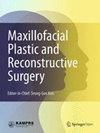采用矢状劈裂臼齿截骨术并去除内部骨干扰对 III 类骨骼错颌畸形患者进行正颌手术后,下颌宽度和额下面部轮廓的变化
IF 2.8
Q2 DENTISTRY, ORAL SURGERY & MEDICINE
Maxillofacial Plastic and Reconstructive Surgery
Pub Date : 2024-09-10
DOI:10.1186/s40902-024-00444-7
引用次数: 0
摘要
本研究的目的是利用锥束 CT 分析骨骼Ⅲ级错颌畸形患者在接受 BSSRO(去除节段间的骨干扰)手术后下颌宽度和正面斜面倾斜度的变化。对所有 20 名受试者分别在术前(T1)、术后即刻(T2)和术后 6 个月(T3)进行了锥形束 CT 成像。使用 R2GATE 软件(MegaGen,韩国首尔)进行了重新定向。在矢状切面上以盂唇和前髁切迹为参考点,在正面切面上以髁头的最外侧点为参考点。所有测量均在正面视图中记录。髁间宽度在T3-T2下降了2.64毫米(P < .001),在T3-T1下降了2.58毫米(P < .05)。趾间宽度在 T3-T2 期减少了 1.75 毫米(P < .05),在 T3-T1 期减少了 3.5 毫米(P < .001)。在正面视图中,以齿根为基础的右侧斜面倾角在 T3-T1 期增加了 2.07°(P < .05)。在 T2-T1 期 间,基于齿槽的左侧斜面倾角增加了 2.45°(P < .05),在 T3-T1 期 间增加了 3.94°(P < .001)。在 T2-T1 期间,基于前龈切迹的右侧斜面倾角增加了 2.35°(P < .05),在 T3-T1 期间增加了 3.04°(P < .01)。基于前对角切迹的左侧斜方肌倾斜度在 T2-T1 增加了 2.73°(P < .001),在 T3-T1 增加了 3.18°(P < .001)。在双侧矢状劈开截骨术中,消除近端和远端之间的骨干扰可减少术后下颌骨宽度,并增加正面视图的斜方肌倾斜度。本文章由计算机程序翻译,如有差异,请以英文原文为准。
Changes in mandibular width and frontal-lower facial profile after orthognathic surgery using sagittal split ramus osteotomy with removal of internal bone interference in patients with class III skeletal malocclusion
The purpose of this study is to analyze changes in mandibular width and frontal view ramus inclination using cone beam CT in patients with skeletal class III malocclusion who underwent BSSRO, with the removal of bone interference between segments. For all 20 subjects, cone-beam CT imaging was performed prior to surgery (T1), immediately post-surgery (T2), and 6 months after surgery (T3). Reorientation was performed using R2GATE software (MegaGen, Seoul, Korea). The gonion and antegonial notch were used as reference points in the sagittal view, and the most lateral point of the condyle head was used as the reference point in the frontal view. All measurements were recorded in the frontal view. Inter-gonial width decreased by 2.64 mm at T3-T2 (P < .001) and by 2.58 mm at T3-T1 (P < .05). Inter-antegonial width decreased by 1.75 mm at T3-T2 (P < .05) and by 3.5 mm at T3-T1 (P < .001). In the frontal view, the right ramus inclination based on the gonion increased by 2.07° at T3-T1 (P < .05). The left ramus inclination based on gonion increased by 2.45° at T2-T1 (P < .05) and by 3.94° at T3-T1 (P < .001). The right ramus inclination based on antegonial notch increased by 2.35° at T2-T1 (P < .05) and by 3.04° at T3-T1 (P < .01). The left ramus inclination based on antegonial notch increased by 2.73° at T2-T1 (P < .001) and by 3.18° at T3-T1 (P < .001). During bilateral sagittal split osteotomy, removing bone interference between the proximal and distal segments results in a reduction of postoperative mandibular width and an increase in frontal view ramus inclination.
求助全文
通过发布文献求助,成功后即可免费获取论文全文。
去求助
来源期刊

Maxillofacial Plastic and Reconstructive Surgery
DENTISTRY, ORAL SURGERY & MEDICINE-
CiteScore
4.30
自引率
13.00%
发文量
37
审稿时长
13 weeks
 求助内容:
求助内容: 应助结果提醒方式:
应助结果提醒方式:


